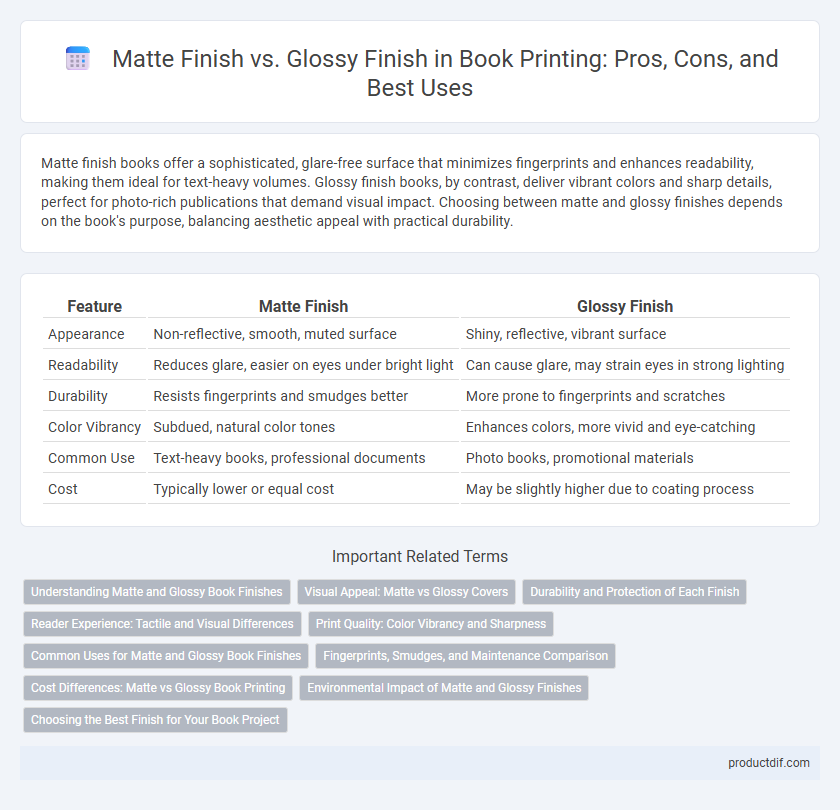Matte finish books offer a sophisticated, glare-free surface that minimizes fingerprints and enhances readability, making them ideal for text-heavy volumes. Glossy finish books, by contrast, deliver vibrant colors and sharp details, perfect for photo-rich publications that demand visual impact. Choosing between matte and glossy finishes depends on the book's purpose, balancing aesthetic appeal with practical durability.
Table of Comparison
| Feature | Matte Finish | Glossy Finish |
|---|---|---|
| Appearance | Non-reflective, smooth, muted surface | Shiny, reflective, vibrant surface |
| Readability | Reduces glare, easier on eyes under bright light | Can cause glare, may strain eyes in strong lighting |
| Durability | Resists fingerprints and smudges better | More prone to fingerprints and scratches |
| Color Vibrancy | Subdued, natural color tones | Enhances colors, more vivid and eye-catching |
| Common Use | Text-heavy books, professional documents | Photo books, promotional materials |
| Cost | Typically lower or equal cost | May be slightly higher due to coating process |
Understanding Matte and Glossy Book Finishes
Matte book finishes offer a non-reflective surface that reduces glare and provides a smooth, elegant look, ideal for covers with intricate details or text-heavy designs. Glossy finishes create a shiny, reflective surface that enhances color vibrancy and contrast, making images and photographs stand out vividly on book covers. Choosing between matte and glossy finishes depends on the desired aesthetic, durability, and readability preferences for the book's presentation.
Visual Appeal: Matte vs Glossy Covers
Matte book covers offer a soft, non-reflective surface that enhances readability and reduces glare under various lighting conditions, making the visuals appear subtle and sophisticated. Glossy finishes create vibrant, high-contrast images that catch the eye with a shiny, reflective quality, emphasizing color depth and detail. Choosing between matte and glossy covers depends on whether the design prioritizes understated elegance or striking visual impact.
Durability and Protection of Each Finish
Matte finishes on books offer superior resistance to fingerprints, scratches, and glare, ensuring longer-lasting protection and a sophisticated, smudge-free appearance. Glossy finishes provide a vibrant, high-shine look but are more prone to visible scratches and fingerprints, which can compromise the book's durability over time. Choosing matte enhances durability for frequently handled books, while glossy suits projects prioritizing vivid color depth with less daily wear.
Reader Experience: Tactile and Visual Differences
Matte finish on book covers offers a smooth, non-reflective surface that reduces glare, enhancing readability under various lighting conditions and providing a soft, tactile sensation that many readers find comforting. Glossy finish, however, delivers vibrant color saturation and sharp contrasts, creating a visually striking appearance, but its reflective surface can cause glare, potentially straining the reader's eyes during prolonged use. The choice between matte and glossy finish significantly influences the reader's tactile engagement and visual comfort, impacting the overall interaction with the book.
Print Quality: Color Vibrancy and Sharpness
Matte finish enhances print quality by reducing glare and offering softer, more muted color vibrancy, ideal for detailed text and images requiring subtle contrast. Glossy finish delivers sharper, more vivid colors with increased contrast and saturation, making images appear more dynamic and eye-catching. Both finishes impact the perception of print sharpness and color intensity, with glossy excelling in brightness and matte providing consistent readability.
Common Uses for Matte and Glossy Book Finishes
Matte finishes on books are commonly used for art books, photography collections, and literary novels due to their non-reflective surface that reduces glare and enhances readability. Glossy finishes are preferred for magazines, cookbooks, and children's books because they provide vibrant color reproduction and a shiny appearance that attracts attention. Publishers often select matte for a sophisticated, understated look, while glossy is chosen to highlight visual content and improve durability against fingerprints.
Fingerprints, Smudges, and Maintenance Comparison
Matte finish book covers resist fingerprints and smudges better than glossy finishes, making them ideal for frequent handling and minimizing visible wear. Glossy finishes, while vibrant and reflective, tend to attract noticeable fingerprints and require more frequent cleaning to maintain their pristine look. Maintenance for matte covers involves simple wiping to remove dust, whereas glossy covers often need gentle polishing to avoid streaks and preserve shine.
Cost Differences: Matte vs Glossy Book Printing
Matte book printing typically incurs higher costs due to the specialized coatings and additional processing steps required to achieve a non-reflective surface, enhancing durability and reducing glare. Glossy book printing is generally more cost-effective as it uses standard lacquer finishes that produce vibrant colors and a shiny appearance with fewer manufacturing complexities. Choosing between matte and glossy finishes significantly impacts production expenses, with matte finishes often adding 10-20% more to printing budgets compared to glossy options.
Environmental Impact of Matte and Glossy Finishes
Matte finishes typically use less energy during production and often involve water-based coatings, resulting in lower VOC emissions compared to glossy finishes, which frequently require solvent-based varnishes with higher environmental impact. Matte coatings tend to be more biodegradable and easier to recycle, whereas glossy finishes can contain plastics and heavy metals that complicate recycling processes. Choosing matte finished books reduces overall ecological footprint by supporting sustainable manufacturing and promoting easier material recovery.
Choosing the Best Finish for Your Book Project
Matte finish offers a smooth, non-reflective surface ideal for minimizing glare and enhancing readability, making it perfect for text-heavy books or those seeking a sophisticated, understated look. Glossy finish provides vibrant color saturation and a shiny, eye-catching appearance ideal for photography books, children's books, or covers that require high visual impact. Selecting the best finish depends on the book's content, target audience, and desired aesthetic, balancing durability with the intended tactile and visual experience.
Matte Finish vs Glossy Finish Infographic

 productdif.com
productdif.com